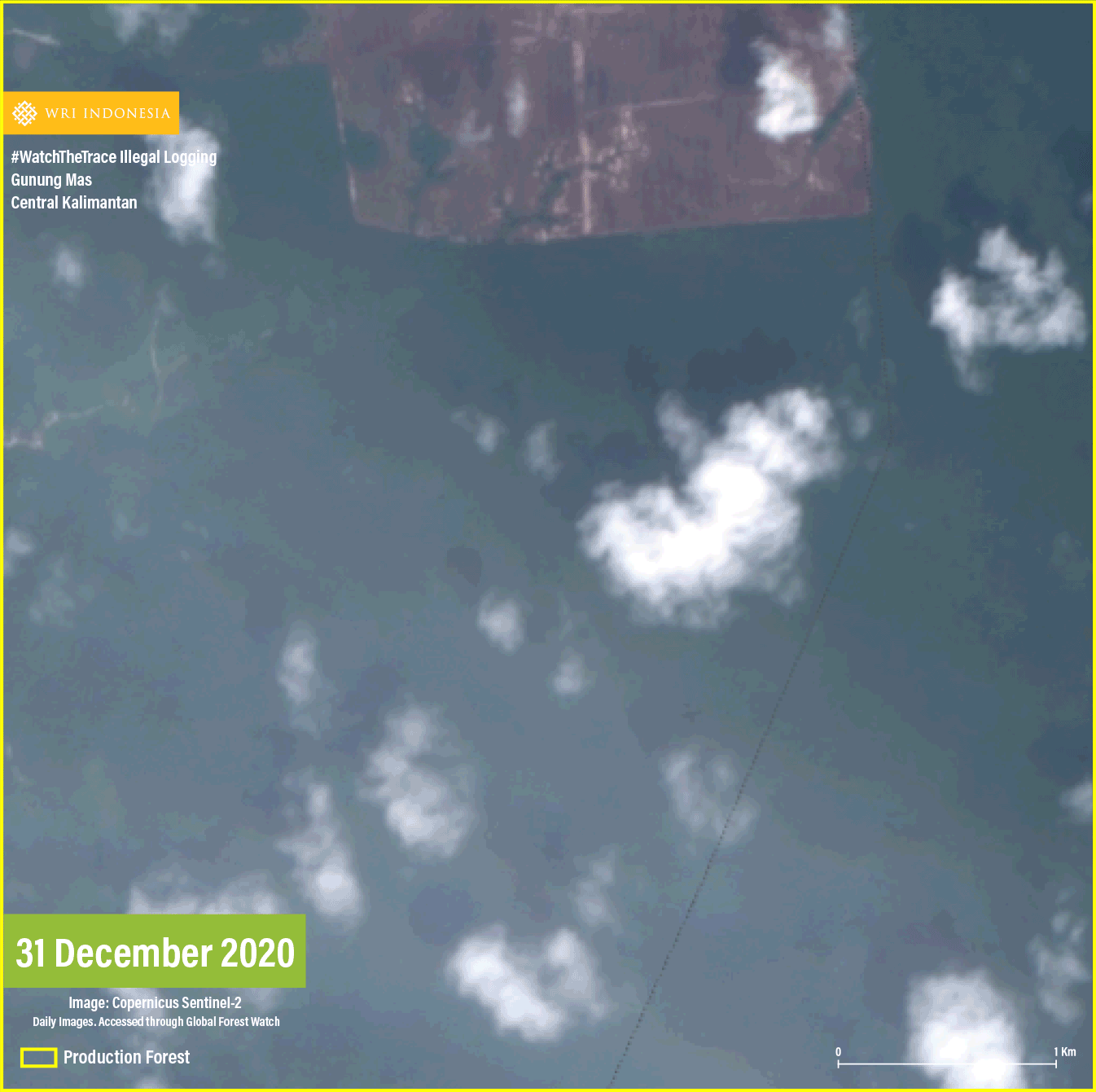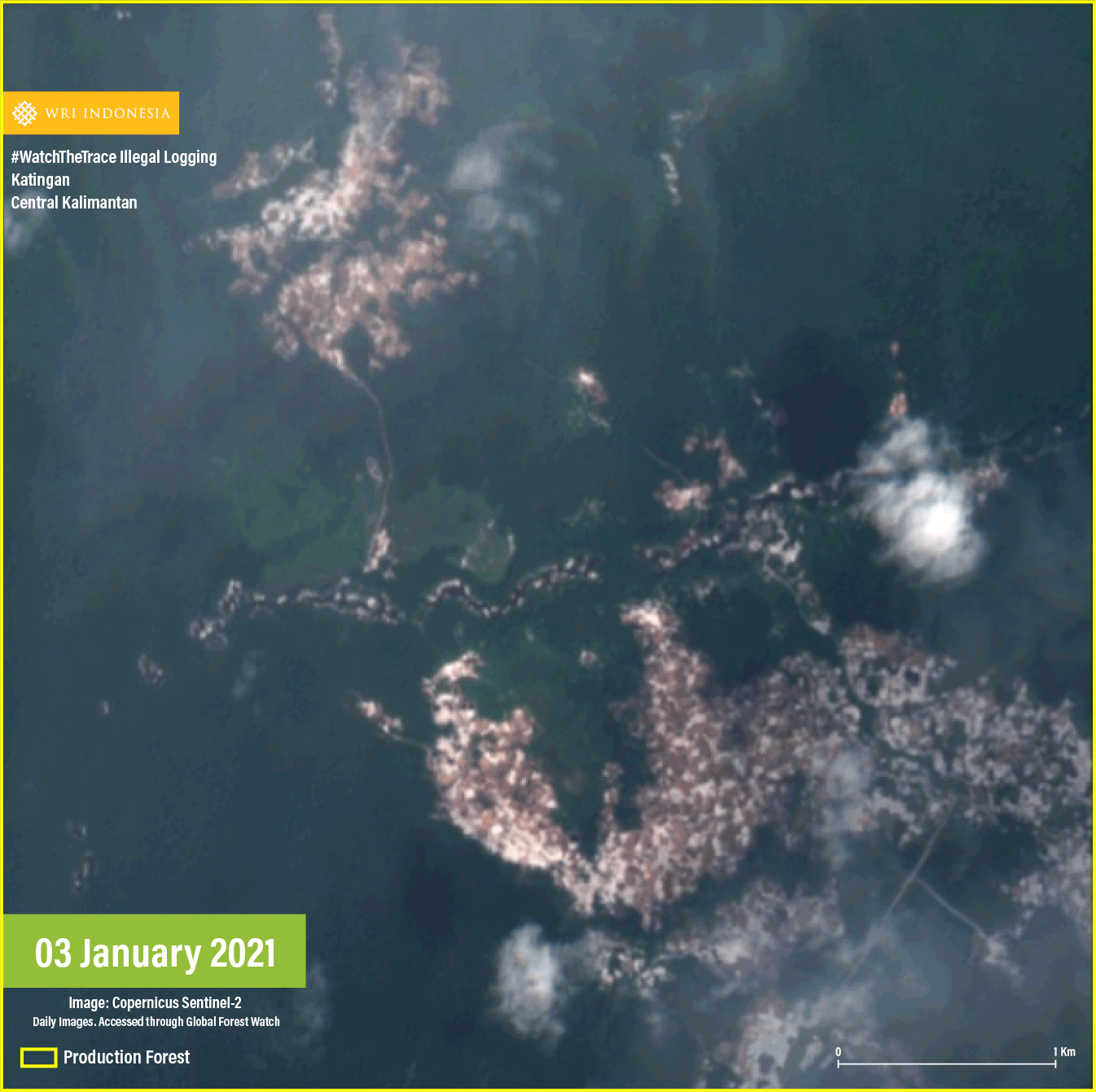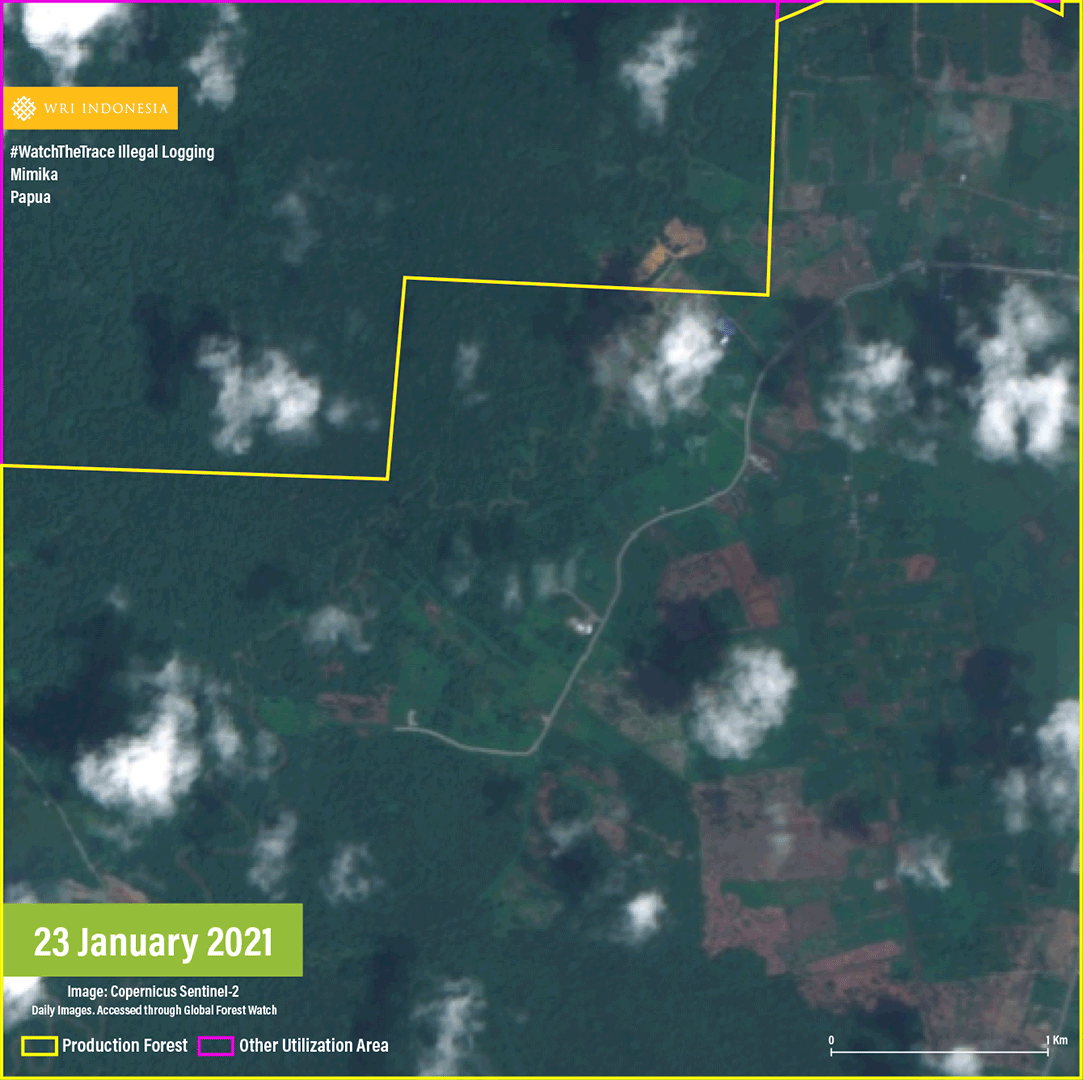
Places to Watch 13th Edition: Five Indicated Illegal Logging Area in Indonesia
This thirteenth edition features the top 5 Places to Watch for indications of illegal logging between 1 January and 31 March 2021. Places to Watch uses the method and data of GLAD Alert from Global Forest Watch, which is analyzed quarterly.
#1 Tewai Baru Village, Sepang Simin Subdistrict, Gunung Mas District, Central Kalimantan: 103.59 Ha

Indicated area #1 is in the Central Kalimantan Production Forest Management Unit (KPHP) Unit XIII with secondary dryland forest cover. This area is bordered by Industrial Plantation Forest (HTI) concession in the east and an oil palm concession in the west. Satellite images show that the forest clearing is an extension of the previous clearing and is connected to the existing road network. The reason for the forest clearing is uncertain since the cleared area has not been utilized by the end of the observation period.
In December 2020, a production forest was cleared for cassava plantations in Tewai Baru Village, as part of the government's food estate program. Local NGO complained about the lack of information from the government regarding the licensing and administration of timber in this food estate project, so that indications of legalized environmental crimes are difficult to prove.
#2 Tarusan Danum Village, Tewang Sangalang Garing Subdistrict, Katingan District, Central Kalimantan: 95,48 Ha

Indicated area #2 is in a production forest and is a secondary swamp forest cover. The forest clearing is indicated to be in an oil palm plantation concession area that does not have a Forest Estate Release Permit (IPKH) and is adjacent to an Industrial Plantation Forest (HTI) concession area in the west. Although the location is within an oil palm plantation concession, satellite imagery shows that the forest clearing is an extension of the existing open pit mining activities. This mining activity is indicated to be carried out illegally because there is no Borrow-Use Permit for Forest Areas (IPPKH) for Mining Business Permits (IUP).
Specific reports on illegal activities in the indicated area #2 (Tarusan Danum Village) are not found through online searches. However, in April 2020, it was reported that Tewang Senggalang Subdistrict is one of the subdistricts that is vulnerable to illegal gold mining in Katingan District.
#3 Perumpaken Benjadi Village, Mesidah Subdistrict, Bener Meriah District, Aceh: 88,29 Ha

Indicated area #3 is in a protected forest managed by the Aceh Protected Forest Management Unit (KPHL) III with secondary dryland forest cover. Satellite images show that forest clearing was done in a scattered and irregular pattern. The cleared forest land had not been utilized by the end of the observation period, but we assume that it will be used for the expansion of dryland agriculture as the surrounding land cover. No specific reports were found regarding illegal activities in the indicated area #3 (Perumpaken Benjadi Village). However, in July 2020, it was reported that up to thousands of hectares of lands were cleared in the protected forest area in Mesidah Subdistrict but no legal action was taken for the crime.
#4 Timika Indah Village, Mimika Baru Subdistrict, Mimika District, Papua Province: 64.53 Ha

Indications of forest clearing were found in Production Forest Area with secondary dryland forest cover. The area is the expansion of forest clearing covered in the ninth edition of Places to Watch, indicated area #5, which was done in the same period (January-March) exactly a year earlier and was indicated to be in an oil palm plantation concession area. The pattern of forest clearing in this period looks similar to the previous one, which is located near the access road. Satellite imagery shows that the area cleared in the previous year has not been utilized and has been overgrown with vegetation such as grass and shrubs. By the end of the observation period, the newly cleared area also has not been utilized and appears to be open land.
There are no specific recent reports regarding illegal activities in indicated area #4 (Timika Indah Village and Mimika District). However, the existence of indicated area #4 as an expansion of indicated area #5 in Places to Watch the ninth edition shows the need for field verification to prevent further forest clearing.
#5 Baru Lempur Village, Gunung Raya Subdistrict, Kerinci District, Jambi: 63,09 Ha

Indications of forest clearing were found in the Kerinci Seblat National Park (TNKS) conservation area, which is part of the UNESCO World Natural Heritage Sites. The indicated area #5 is secondary dryland forest and an expansion from area 4 in the first edition. Satellite imagery shows that the expansion of forest clearing is in the southern part of the cleared area covered in the first edition with a relatively similar clearing pattern. The reason for the forest clearing is uncertain since the cleared area has not been utilized by the end of the observation period.
No specific reports were found regarding illegal activities in the indicated area #4 (Baru Lempur Village). However, it was reported that illegal logging was quite massive in the TNKS area and the limited number of personnel in the TNKS Center could not take any action. Moreover, based on research in 2018, the local communities use the TNKS area as agricultural land.
The Next Step
The Five Places to Watch are identified based on indications analyzed using various instruments such as GLAD Alert data from Global Forest Watch, as well as the Forest Area Status Map, Forest Area Utilization Map, and Land Cover/Utilization Map downloaded from the MoEF Geoportal website. However, this analysis can be used in determining the areas where monitoring for illegal logging must be prioritized. To that end, the following steps need to be taken immediately by the authorities.
1. 1. Field Verification and Action to Prevent Expansion of Illegal Logging in the Five Indicated Areas.
In this edition, the indicated areas #4 and #5 need special attention because both are extensions of the previous clearing. Area #4 is an expansion of clearing in 2020 and area #5 is an expansion of clearing in 2018 which is located in the TNKS Area. These expansions show that there has been no action taken on the previous forest clearing activities. The Ministry of Environment and Forestry/National Park Office/Forest Management Unit (KPH) and the local government need to take more serious actions and actively collaborate with various relevant parties in conducting forest monitoring and preventing the expansion of forest clearing. For instance, they should disseminate information, educate, and assist local communities to formulate the best schemes for the communities and forest protection.
Central Kalimantan Province also needs special attention because two areas with the largest indications (areas #1 and #2) are located there. Area #3 in Bener Meriah District, Aceh Province, is a new area in the Places to Watch list, but in 2020, WRI Indonesia through the Leuser Conservation Forum (FKL) found that illegal forest clearing had occurred in this area. Forest loss in the Leuser Ecosystem Area (KEL) needs to be prevented immediately so that it does not continue because the KEL is a tropical forest with a high level of biodiversity and ecological function in Sumatra.
Authorities in charge of forest protection at the five indicated areas, such as the relevant Forest Management Units (KPH), National Park Office, Directorate General of Law Enforcement under the Ministry of Environment and Forestry, Province Forest Service, and the local Police, must collaborate to conduct field verification and take preventive measures to prevent further illegal logging and illegal forest utilization.
Community participation in providing information from the field may help in the verification process. If field verification and preventive measures to prevent further forest clearing are not conducted promptly, illegal logging will grow massively and the negative environmental impact will be inevitable. As the forest area that has been cleared and utilized for non-forestry activities grows larger, its mitigation and restoration will become more challenging.
2. Upon Verification, the Handling Process Must Take Into Account Socio-Economic Background of Local Communities.
Illegal logging in the indicated area #3 is assumed to be closely associated with small-scale economic activities. As such, upon verification, the handling process must take into account the socio-economic background of the local communities. The handling mechanism may consider various conflict resolution schemes and area management options through social forestry, agrarian reform, and fair law enforcement. In addition, it is also necessary to trace the perpetrators back to the masterminds (intellectual players and funders) who are reaping the ultimate benefits of illegal logging, and not only tracing the executors.
3. Cooperation with the Local Forestry Office and Forest Monitoring Community Organizations.
WRI Indonesia has introduced many data and tools that are used in the analysis for this Places to Watch to the Forest Management Unit (KPH) and National Park staff, community organizations, and Independent Forestry Monitoring Networks as part of the collaboration in forest monitoring to prevent illegal logging. Places to Watch data is an initial indication that can then be used by related parties to conduct field verification in order to obtain stronger evidence for law enforcement. Multi-stakeholder collaboration can result in more effective and efficient monitoring and prevention because each agency has different resources, expertise, and authority to take action.